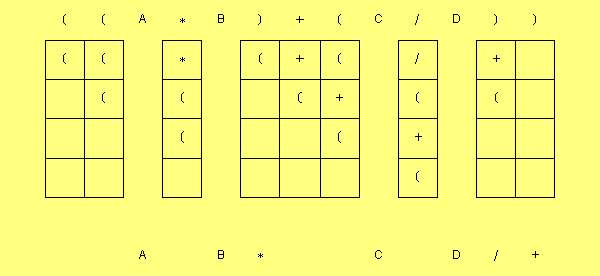Program For Evaluating Postfix Expression Using Stacking

Infix Expression Prefix Expression Postfix Expression Evaluation of Postfix. (Using Stack) C Program to. Evaluation of postfix expression: Using stack. Evaluate a postfix expression using a stack and. Will not complete the program. Like it is stuck in. Example for evaluating postfix expression.
Xilisoft Register Code. Using a Stack to Evaluate an Expression Using a Stack to Evaluate an Expression We often deal with arithmetic expressions written in what is called infix notation: Operand1 op Operand2 We have rules to indicate which operations take precedence over others, and we often use parentheses to override those rules. It is also quite possible to write arithmetic expressions using postfix notation: Operand1 Operand2 op With postfix notation, it is possible to use a stack to find the overall value of an infix expression by first converting it to postfix notation. Example: Suppose we have this infix expression Q: 5 * ( 6 + 2 ) - 12 / 4 The equivalent postfix expression P is: 5 6 2 + * 12 4 / - This discussion assumes all our operations are binary operations (2 arguments each). Notice that we also sometimes use unary operations such as ++ or -- or the unary + and. We are not including the possibility of array elements in this discussion.
(The subscript can be an expression which would have to be evaluated.) One way to think of an expression is as a list or sequence of items, each of which is a left parenthesis, right parenthesis, argument, or operator. An argument can be a constant or the name of a variable. Presumably it would be necessary at some point to replace each variable with its value. There are two algorithms involved. One converts an infix expression to postfix form, and the other evaluates a postfix expression.
Each uses a stack. Transform an infix expression to postfix notation Suppose Q is an arithmetic expression in infix notation.
We will create an equivalent postfix expression P by adding items to on the right of P. The new expression P will not contain any parentheses.
We will use a stack in which each item may be a left parenthesis or the symbol for an operation. Start with an empty stack. We scan Q from left to right.
The Postfix notation is used to represent algebraic expressions. The expressions written in postfix form are evaluated faster compared to infix notation as parenthesis are not required in postfix.
We have discussed. Download Mukesh Songs Free there. In this post, evaluation of postfix expressions is discussed.
Following is algorithm for evaluation postfix expressions. 1) Create a stack to store operands (or values). 2) Scan the given expression and do following for every scanned element..a) If the element is a number, push it into the stack.b) If the element is a operator, pop operands for the operator from stack. Evaluate the operator and push the result back to the stack 3) When the expression is ended, the number in the stack is the final answer Example: Let the given expression be “2 3 1 * + 9 -“. We scan all elements one by one. 1) Scan ‘2’, it’s a number, so push it to stack. Stack contains ‘2’ 2) Scan ‘3’, again a number, push it to stack, stack now contains ‘2 3’ (from bottom to top) 3) Scan ‘1’, again a number, push it to stack, stack now contains ‘2 3 1’ 4) Scan ‘*’, it’s an operator, pop two operands from stack, apply the * operator on operands, we get 3*1 which results in 3.
We push the result ‘3’ to stack. Stack now becomes ‘2 3’. 5) Scan ‘+’, it’s an operator, pop two operands from stack, apply the + operator on operands, we get 3 + 2 which results in 5. We push the result ‘5’ to stack. Stack now becomes ‘5’.
6) Scan ‘9’, it’s a number, we push it to the stack. Stack now becomes ‘5 9’.
7) Scan ‘-‘, it’s an operator, pop two operands from stack, apply the – operator on operands, we get 5 – 9 which results in -4. We push the result ‘-4’ to stack. Stack now becomes ‘-4’.
8) There are no more elements to scan, we return the top element from stack (which is the only element left in stack).